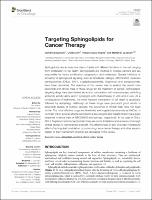| dc.contributor | Vall d'Hebron Barcelona Hospital Campus |
| dc.contributor.author | Companioni, Osmel |
| dc.contributor.author | Mir Perez, Cristina |
| dc.contributor.author | Garcia Mayea, Yoelsis |
| dc.contributor.author | Lleonart Pajarin, Matilde |
| dc.date.accessioned | 2022-05-18T07:48:58Z |
| dc.date.available | 2022-05-18T07:48:58Z |
| dc.date.issued | 2021-10-19 |
| dc.identifier.citation | Companioni O, Mir C, Garcia-Mayea Y, LLeonart ME. Targeting Sphingolipids for Cancer Therapy. Front Oncol. 2021 Oct 19;11:745092. |
| dc.identifier.issn | 2234-943X |
| dc.identifier.uri | https://hdl.handle.net/11351/7543 |
| dc.description | Càncer; Esfingolípids; Teràpia |
| dc.description.sponsorship | This work was supported by grants from the Instituto de Salud Carlos III (ISCIII; PI20/00556 and CP03/00101 [ML]) and CIBERONC (ML). This work was also co-financed by the European Regional Fund (ERDF) and AECC (Spanish Association of Cancer Research) (Founding Ref. GC16173720CARR [ML]). YG-M and CM were supported by the VHIR and iP-FIS (ISCIII) fellowships, respectively. |
| dc.language.iso | eng |
| dc.publisher | Frontiers Media |
| dc.relation.ispartofseries | Frontiers in Oncology;11 |
| dc.rights | Attribution 4.0 International |
| dc.rights.uri | http://creativecommons.org/licenses/by/4.0/ |
| dc.source | Scientia |
| dc.subject | Càncer - Tractament |
| dc.subject | Esfingolípids |
| dc.subject | Quimioteràpia combinada |
| dc.subject.mesh | Sphingolipids |
| dc.subject.mesh | Neoplasms |
| dc.subject.mesh | /drug therapy |
| dc.subject.mesh | Drug Therapy, Combination |
| dc.title | Targeting Sphingolipids for Cancer Therapy |
| dc.type | info:eu-repo/semantics/article |
| dc.identifier.doi | 10.3389/fonc.2021.745092 |
| dc.subject.decs | esfingolípidos |
| dc.subject.decs | neoplasias |
| dc.subject.decs | /farmacoterapia |
| dc.subject.decs | farmacoterapia combinada |
| dc.relation.publishversion | https://doi.org/10.3389/fonc.2021.745092 |
| dc.type.version | info:eu-repo/semantics/publishedVersion |
| dc.audience | Professionals |
| dc.contributor.organismes | Institut Català de la Salut |
| dc.contributor.authoraffiliation | [Companioni O, Mir C, Garcia-Mayea Y] Grup de Recerca Biomèdica en Cèl•lules Mare del Càncer, Vall d’Hebron Institut de Recerca (VHIR), Barcelona, Spain. Universitat Autònoma de Barcelona, Bellaterra, Spain. [LLeonart ME] Grup de Recerca Biomèdica en Cèl•lules Mare del Càncer, Vall d’Hebron Institut de Recerca (VHIR), Barcelona, Spain. Universitat Autònoma de Barcelona, Bellaterra, Spain. Spanish Biomedical Research Network Center in Oncology, CIBERONC, Madrid, Spain |
| dc.identifier.pmid | 34737957 |
| dc.identifier.wos | 000715815600001 |
| dc.relation.projectid | info:eu-repo/grantAgreement/ES/PE2017-2020/PI20%2F00556 |
| dc.rights.accessrights | info:eu-repo/semantics/openAccess |

